The Kingston A1000 NVMe SSD Review: Phison E8 Revisited
by Billy Tallis on July 2, 2018 8:00 AM ESTRandom Read Performance
Our first test of random read performance uses very short bursts of operations issued one at a time with no queuing. The drives are given enough idle time between bursts to yield an overall duty cycle of 20%, so thermal throttling is impossible. Each burst consists of a total of 32MB of 4kB random reads, from a 16GB span of the disk. The total data read is 1GB.

The burst random read performance of the Kingston A1000 is slightly lower than that of the MyDigitalSSD SBX, and barely half that of the Toshiba RC100, both of which use the same NAND flash memory as the A1000. The older Phison E7 drives with MLC NAND are only a little bit slower than the fastest current-generation SSDs.
Our sustained random read performance is similar to the random read test from our 2015 test suite: queue depths from 1 to 32 are tested, and the average performance and power efficiency across QD1, QD2 and QD4 are reported as the primary scores. Each queue depth is tested for one minute or 32GB of data transferred, whichever is shorter. After each queue depth is tested, the drive is given up to one minute to cool off so that the higher queue depths are unlikely to be affected by accumulated heat build-up. The individual read operations are again 4kB, and cover a 64GB span of the drive.
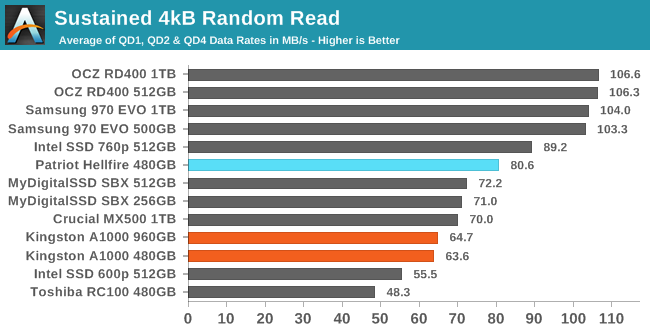
On the longer random read test, the A1000's performance shortfall relative to the SBX is even wider, and the A1000 is one of the slowest current-generation NVMe drives on this test. The Toshiba RC100's performance is in last place, because the sustained random read test covers a larger portion of the drive than the RC100's host memory buffer is set up to cache metadata for.
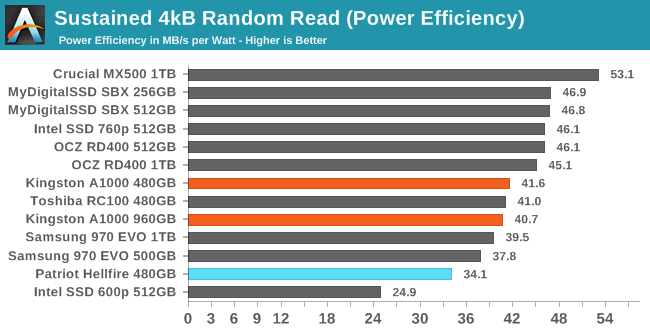 |
|||||||||
| Power Efficiency in MB/s/W | Average Power in W | ||||||||
The power consumption of the Kingston A1000 during random reads is only slightly higher than the SBX, but since performance is also worse that adds up to a clear efficiency gap. The SBX is in the top tier of flash-based NVMe SSDs for efficiency on this test, and the A1000 is in the second tier. The older Phison E7-based Patriot Hellfire performed reasonably, but was quite power hungry in comparison to today's drives.
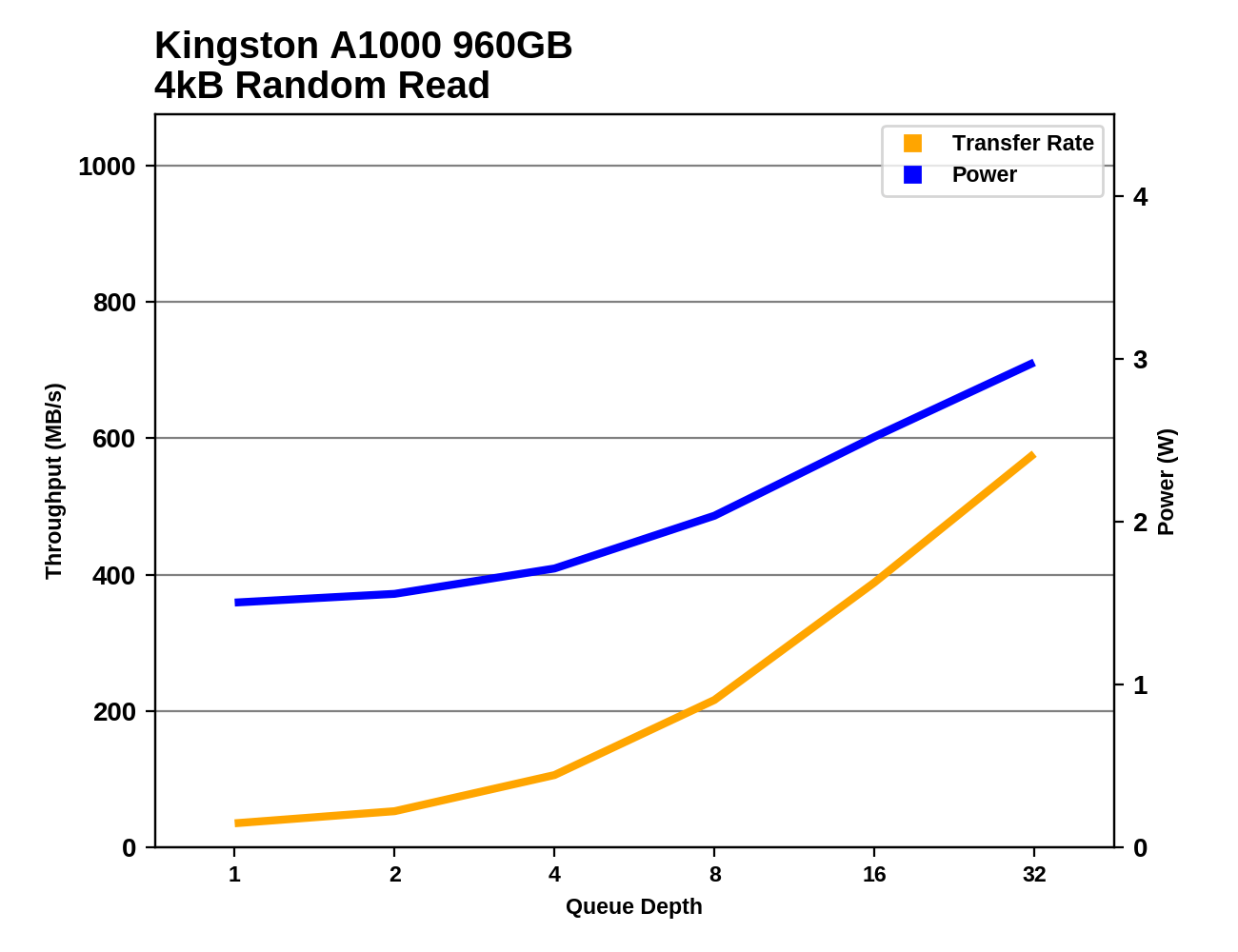 |
|||||||||
The random read performance of the Kingston A1000 shows very good scaling as queue depth increases, though it never manages to catch up to recent high-end NVMe SSDs. However, the sub-par performance at low queue depths is far more important to everyday usage.
Random Write Performance
Our test of random write burst performance is structured similarly to the random read burst test, but each burst is only 4MB and the total test length is 128MB. The 4kB random write operations are distributed over a 16GB span of the drive, and the operations are issued one at a time with no queuing.
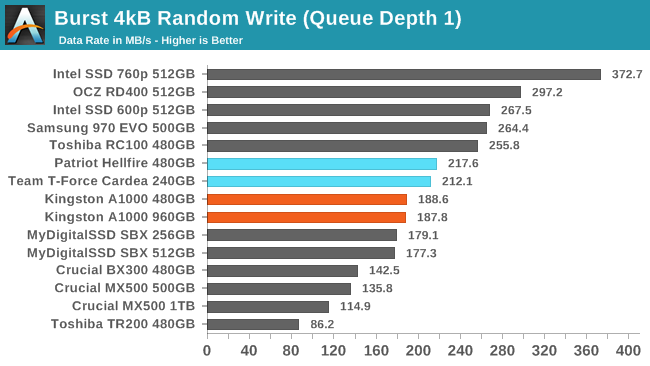
The burst random write performance of the Kingston A1000 is slightly better than the MyDigitalSSD SBX, but both are still behind almost all current NVMe SSDs. The Phison E7 drives with MLC NAND are a bit faster than the A1000 and SBX, so the newer drives are a step backwards in spite of the addition of SLC write caching.
As with the sustained random read test, our sustained 4kB random write test runs for up to one minute or 32GB per queue depth, covering a 64GB span of the drive and giving the drive up to 1 minute of idle time between queue depths to allow for write caches to be flushed and for the drive to cool down.
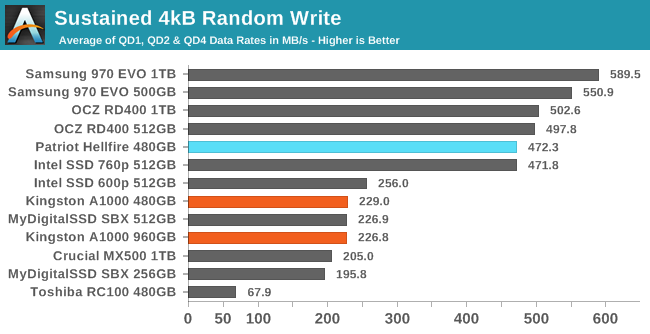
Aside from the Toshiba RC100 falling to last place, nothing looks better for the Kingston A1000 on the longer random write test. The sustained random write performance of the A1000 or the SBX is less than half that of a high-end NVMe SSD.
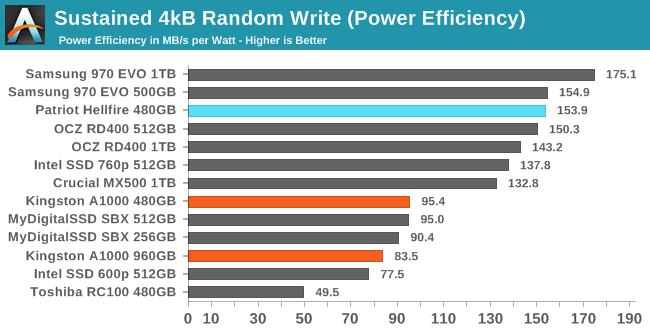 |
|||||||||
| Power Efficiency in MB/s/W | Average Power in W | ||||||||
The 960GB A1000 requires significantly more power during the sustained random write test than the 480GB model, but it offers essentially the same performance, so the larger A1000 has a lower efficiency score. All of the Phison E8 drives fare poorly on this metric compared to high-end NVMe SSDs and good SATA SSDs, but it's not quite the factor of two spread that the raw performance shows.
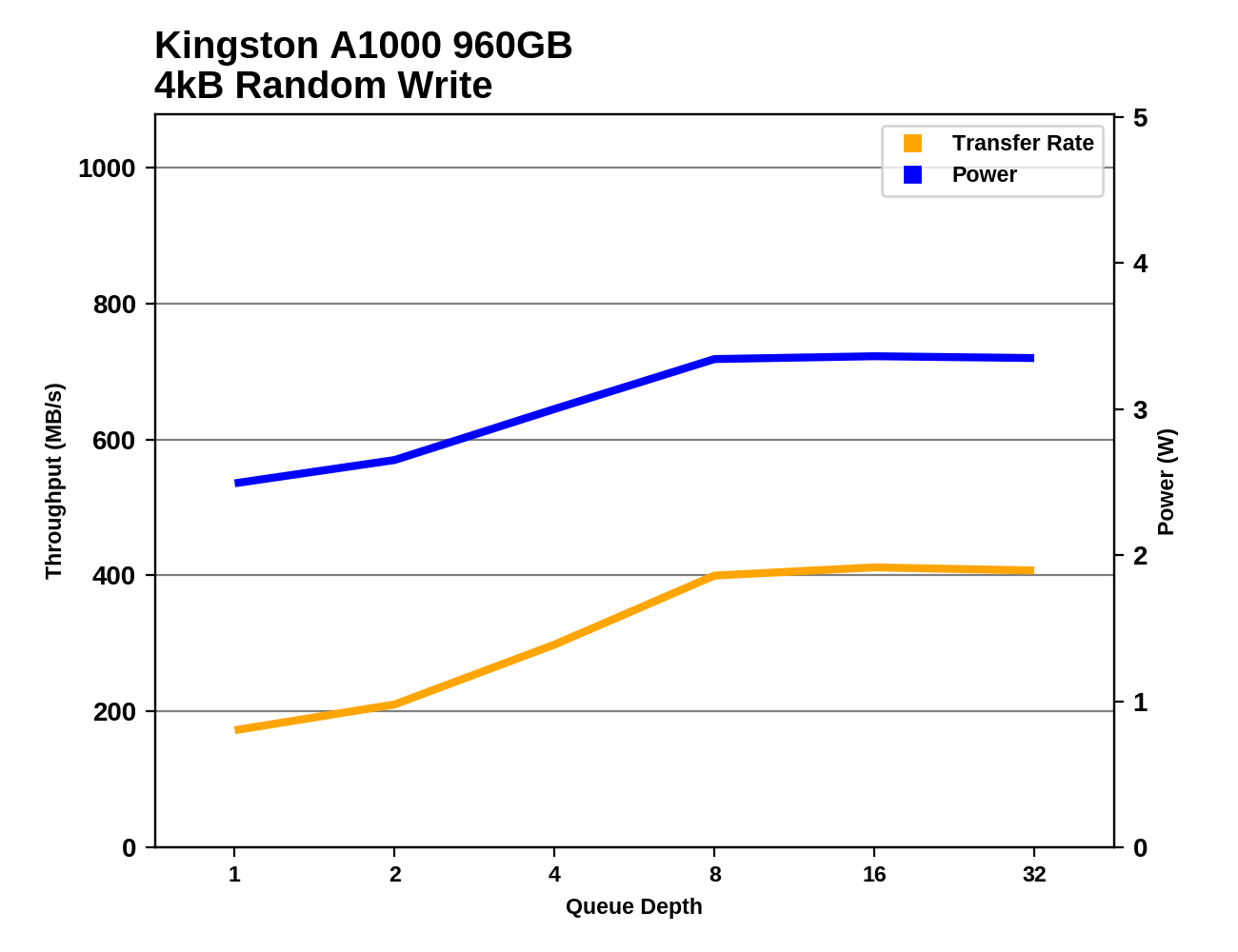 |
|||||||||
The Kingston A1000 shows similar queue depth scaling behavior to the MyDigitalSSD SBX, with performance topping out at QD8—rather late in the test compared to how most drives behave. Most other NVMe SSDs scale up to higher performance and get there with lower queue depths.










26 Comments
View All Comments
romrunning - Monday, July 2, 2018 - link
Any NVMe drive that doesn't beat the Intel 600p in every category shouldn't be made. I really wish all mfgs would keep NVMe drives to at least PCI x4 & 8 channels with a minimum performance level that is much higher than SATA. The bar for the next tech level of storage products should be at a higher level than the previous.Forget the low-end marked for NVMe. SATA can easily take care of any needs there.
peevee - Monday, July 2, 2018 - link
Given that only Samsung barely saturates PCIex2, and only on artificial tests, at this point even x4 is useless, let alone x8. They'll need many more channels.Actually, I'd prefer x1 for ultra-low-power, if it is fully saturated in more or less real-life tests (like AT's "Light"), vs x4 which only saturates 1/10th of x1 capacity.
romrunning - Tuesday, July 3, 2018 - link
I was thinking more along the lines of every mfg creating NVMe drives have to attain to a minimum performance level. It becomes easier to understand what is higher-performing from the end-user's perspective. So if NVMe's minimum performance level is 2x SATA, then anytime you see NVMe you know it's better than SATA. Too bad whatever storage consortium finalized specs for NVMe didn't require min perf levels for storage.It's annoy to me when these mfgs put out "new" drives that don't exceed the older tech.
FunBunny2 - Monday, July 2, 2018 - link
" I really wish all mfgs would keep NVMe drives to at least PCI x4 & 8 channels with a minimum performance level that is much higher than SATA. "some wag put it, "you sell the sizzle, not the steak".
Gunbuster - Tuesday, July 3, 2018 - link
Okay Kingston, reviews are done, feel free to swap in cheaper/slower NAND chips. ;)Ratman6161 - Tuesday, July 3, 2018 - link
In the ATSB Heavy Data Rate chart, for the 1TB 970 EVO, I think you have the full and empty numbers transposed. I.e. you show 525 empty and 635 full. I assume that should be 635 empty and 525 full?Billy Tallis - Tuesday, July 3, 2018 - link
They're not transposed. I'm not sure what happened with those test runs, but I'm re-running them. I do know that Samsung drives lie about when they've finished a secure erase, so it's possible the "empty" drive test run was still working on an erase operation in the background even though I try to ensure all drives have plenty of idle time to finish cleaning up after they claim to be done erasing.leexgx - Wednesday, July 4, 2018 - link
Surprised it works like that when using secure erase, zapping page area and all NAND chips should not take long to do, also what can i use to use secure erase on all drives (seagate own tool seems to lack it, it has full erase but it's not secure erase and it killed my seagate firecuda doing it)SanX - Tuesday, July 3, 2018 - link
Everyone here knows that in the shops the average Joe will see on the product tag "Sequential Read 1500 MB/s" which is plain lie and conveniently keeps mum about this. Which test gives 1500, show me? At best 2-3 times less.This site degraded long ago to serve salespeople.
rocky12345 - Wednesday, July 4, 2018 - link
Great review but this drive does seem rather unimpressive for sure. It acts like it doe snot have a dram cache at all since most if it's scores are well below the mark. I like Kingston for their memory products which work well in the systems I build for my clients. These NVMe drives that are considered lower end give a false picture of great speed and performance because NVMe drives are known for their great performance level. Then you get these drives trying to break into this sector and do not perform any where close to what you would expect from a NVMe drive. Heck my samsung 860 Pro 512GB Sata SSD can get better numbers in a lot of the tests done in the review than these cheap low end NVMe drives and it is only based off of the Sata port and limited to a max 600MB's from the port itself that is kinda sad if you think about it really.